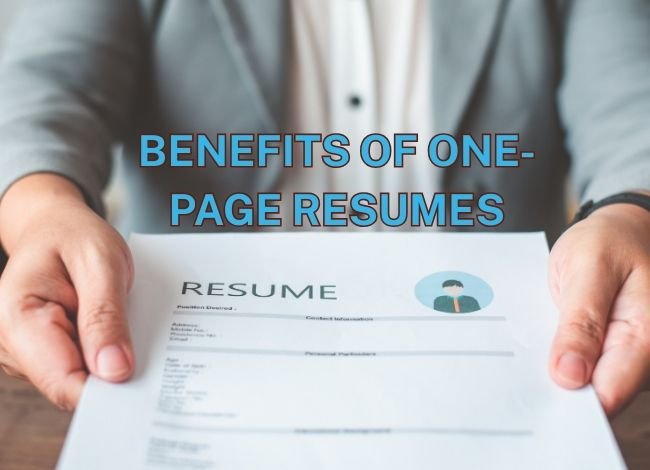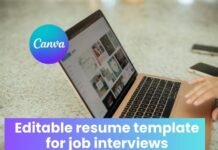In today’s fast-paced job market, recruiters and hiring managers often spend less than 10 seconds scanning a resume before deciding whether to keep reading. For busy professionals, this means every word, bullet point, and design choice must be strategic. A one-page resume template for busy professionals provides the perfect solution—concise, clear, and impactful. By distilling your skills, experience, and achievements onto a single page, you can showcase your professional brand effectively without overwhelming the reader.
This article will explore whether a resume must be one page, the benefits of one-page resumes, how to use one-page resume templates, and actionable strategies to make your resume concise yet powerful. Whether you’re an experienced executive or just starting your career, learning to craft a single-page resume will give you a competitive edge.
Does a Resume Have to Be One Page?
The age-old debate—should a resume be one page or two? The truth is, it depends on your career stage, industry, and job requirements. Traditionally, recruiters preferred one-page resumes because they are easier to review quickly. However, two-page resumes are also accepted in certain circumstances, especially for candidates with over 10 years of experience or those in research, academia, or technical industries.
Still, a one-page resume often works best in today’s digital hiring environment. Applicant Tracking Systems (ATS) do not discriminate against length, but human recruiters appreciate brevity. If you can highlight your strongest qualifications and quantifiable achievements on one page, you maximize the chances of making a strong first impression.
Benefits of One-Page Resumes

Why should you consider using a one-page resume template for busy professionals? Here are the top benefits:
- Time-Efficient for Recruiters
Hiring managers are usually pressed for time. A one-page format ensures they can quickly find the most relevant information. - Focused Messaging
A concise resume forces you to eliminate fluff and focus on measurable accomplishments, making your application stronger. - ATS & Human-Friendly
While ATS can process longer resumes, recruiters prefer shorter formats. A one-page resume balances both. - Professional Appearance
Minimalist designs and compact layouts project confidence and professionalism, ideal for busy professionals. - Portability
One-page resumes print neatly, are easier to email, and are perfect for networking events, career fairs, and job interviews.
One-Page Resume Templates
Templates play a critical role in helping professionals keep resumes concise yet visually appealing. A one-page resume template for busy professionals typically includes the following sections:
- Header: Name, contact information, LinkedIn, and optional portfolio links.
- Professional Summary: A short 3-4 sentence overview of your career highlights and value proposition.
- Core Skills: A bulleted list of technical and soft skills relevant to the job.
- Professional Experience: Reverse chronological order with 2–4 concise bullet points per role, highlighting achievements.
- Education: Degree(s), certifications, or licenses.
- Optional Section: Awards, publications, or volunteer experience if highly relevant.
Modern templates often use subtle design elements such as color blocks, icons, or bold headings to enhance readability without distracting from content. Platforms like Canva, Microsoft Word, and Google Docs provide free or paid templates, while professional resume services offer customized designs optimized for ATS.
Should a Resume Be One Page or Two Pages?
The decision between a one-page and a two-page resume depends on multiple factors, but the guiding principle is relevance. A resume isn’t meant to be a complete career autobiography—it’s a marketing tool designed to secure an interview.
For busy professionals, a one-page resume template offers clarity and efficiency. If you can communicate your qualifications in a single page without sacrificing key details, you should absolutely choose this format. However, in some cases, two pages may be justified, especially if you have extensive leadership roles, technical expertise, or multiple industries under your belt.
Think of it this way: recruiters want to see the highlights, not every task you’ve ever completed. If your resume looks like a dense wall of text, trimming it down to one page will make it far more effective.
Level of Experience
Your career stage is one of the biggest factors in deciding whether a resume should be one or two pages:
- Entry-Level Professionals (0–3 years of experience):
A one-page resume is almost always the best choice. Recruiters do not expect a long employment history at this stage. Instead, focus on internships, academic projects, part-time jobs, and transferable skills. - Mid-Career Professionals (4–10 years of experience):
Most professionals in this range can still use a one-page resume. Highlight only the most impactful roles, achievements, and leadership experiences. Compress older or less relevant jobs into a “Previous Experience” section if needed. - Senior-Level & Executives (10+ years of experience):
In some cases, a two-page resume makes sense. C-suite executives, researchers, or professionals in fields like engineering and healthcare may need more space to cover complex roles, patents, or publications. However, even at this level, keeping your resume concise is essential.
The bottom line: if you can fit your qualifications into one page without cutting out essential achievements, do it.
Industry Norms
Different industries have different expectations regarding resume length:
- Creative Fields (Marketing, Design, Media):
One-page resumes are highly preferred. Creativity and brevity signal strong communication skills. A visually polished template can make you stand out. - Technology (IT, Software, Engineering):
One-page resumes work well, but for highly technical professionals, two pages may be acceptable if detailing projects, coding languages, or systems is necessary. - Academia & Research:
These fields often expect a CV (Curriculum Vitae), which is longer and more detailed. However, for industry jobs outside academia, a one-page resume is still the norm. - Corporate Roles (Finance, Consulting, HR):
Recruiters expect clean, one-page resumes. The ability to condense information into a crisp format reflects professionalism and analytical skills.
Understanding industry norms ensures you align your resume with recruiter expectations.
Job Requirements
Another factor that determines resume length is the specific role you’re applying for. Some jobs demand specialized skills or certifications that must be included, while others focus more on general leadership and achievements.
For example:
- A project manager may need to include certifications like PMP or PRINCE2.
- A software engineer may need to list programming languages, frameworks, and notable projects.
- A creative professional may emphasize design portfolios and campaign highlights.
Even when job requirements are detailed, you should prioritize relevance. Ask yourself: Does this detail help me get hired for this specific role? If the answer is no, leave it out.
Recruiters are not impressed by quantity—they’re impressed by quality. The strongest resumes emphasize skills and achievements directly tied to the position, making the one-page format ideal for most busy professionals.
How to Fit a Resume on One Page
Fitting years of experience, skills, and achievements onto one page can feel like a challenge. But with the right strategies, it’s absolutely achievable. Here’s how to streamline your resume without losing impact:
Prioritize Relevance
Only include jobs, skills, and experiences that directly relate to the role you’re applying for. Recruiters don’t need to see every part-time job you had in college unless it adds value.Use Strategic Formatting
Choose a clean, ATS-friendly template with consistent font size (10–12 pt for text, 14–16 pt for headings). Minimize spacing, avoid large graphics, and keep margins between 0.5–0.75 inches.Condense Older Roles
If you’ve been in the workforce for 10+ years, you don’t need to detail every early role. Summarize older positions in a “Previous Roles” section.Focus on Achievements, Not Duties
Instead of writing long lists of responsibilities, emphasize measurable results. For example, “Increased sales by 25% in six months” is more impactful than “Responsible for managing sales team.”Leverage Bullet Points
Keep bullet points concise—one to two lines each. Use action verbs and quantifiable metrics wherever possible.Cut Unnecessary Details
Remove outdated skills (e.g., Windows XP proficiency) and irrelevant experiences. Keep your resume fresh and aligned with the current job market.
By applying these strategies, you’ll fit your content into a single, polished page without compromising quality.
One-Page Resume Builder
For busy professionals, a one-page resume builder can save valuable time while ensuring your resume remains professional and effective. These tools typically offer drag-and-drop formatting, ATS optimization, and modern layouts.
Popular one-page resume builders include:
- Canva: Great for creative fields with visually appealing templates.
- Zety & Novoresume: Provide structured, ATS-compliant templates with customization options.
- Kickresume: Offers templates tailored to industries and allows portfolio integration.
- Microsoft Word & Google Docs: Reliable, easy-to-use, and widely accepted.
Using a builder helps you:
- Maintain consistent formatting.
- Avoid spacing or alignment issues.
- Automatically optimize for one-page layouts.
- Save different versions for multiple job applications.
If you’re a busy professional juggling multiple job applications, a resume builder can cut preparation time in half while ensuring your resume always looks sharp and concise.
What to Leave Off a One-Page Resume
When space is limited, knowing what not to include is just as important as deciding what to keep. Here are items you should leave off:
- Irrelevant Work Experience: Jobs unrelated to your target role (e.g., a cashier job for a senior software engineer).
- Personal Details: Marital status, age, religion, or photo (unless industry-specific, such as modeling).
- Excessive Technical Jargon: Keep it simple and clear; avoid overwhelming recruiters with acronyms.
- Objective Statements: Replace outdated objectives with a powerful professional summary highlighting your value.
- References: These are assumed and can be provided upon request. Don’t waste space listing them.
- Fluff Words: Terms like “hard-working” or “team player” without proof dilute your resume. Show achievements instead.
- Outdated Skills: Remove obsolete technologies or irrelevant tools that don’t enhance your candidacy.
By trimming these elements, you’ll maximize space for the experiences, skills, and achievements that actually matter to hiring managers.
One-Page Resume Format
The format you choose can make or break the effectiveness of your one-page resume. A strong format organizes information logically and emphasizes your key strengths without clutter. Here are the most effective formats for busy professionals:
1. Reverse-Chronological Format
- Best for: Professionals with a steady work history in the same industry.
- Structure: Lists work experience in reverse order, starting with your most recent role.
- Why it works: Recruiters prefer this layout because it quickly shows your career progression and recent accomplishments.
2. Functional (Skills-Based) Format
- Best for: Career changers, freelancers, or those with employment gaps.
- Structure: Focuses on skills and achievements rather than specific job titles.
- Why it works: Allows you to highlight transferable skills instead of drawing attention to gaps or unrelated jobs.
3. Hybrid (Combination) Format
- Best for: Mid-career or senior professionals with both strong skills and work experience.
- Structure: Combines a skills summary with a reverse-chronological experience section.
- Why it works: Balances technical expertise and career trajectory, making it ideal for professionals targeting leadership roles.
Design Best Practices
- Use clear section headers like “Professional Summary,” “Experience,” and “Skills.”
- Keep fonts professional (e.g., Arial, Calibri, or Times New Roman).
- Use bold and italics sparingly to guide the reader’s eyes.
- Ensure proper white space for readability.
The right format ensures that recruiters can navigate your resume quickly while highlighting your most relevant achievements.
One-Page Resume Writing Tips
Even the most polished template won’t work if the content isn’t compelling. Here are key writing tips to make your one-page resume impactful:
1. Start With a Strong Professional Summary
- Replace outdated objectives with a 2–4 sentence summary.
- Highlight your years of experience, major achievements, and value proposition.
- Example: “Marketing professional with 7+ years of experience driving digital campaigns, improving ROI by 40%, and managing cross-functional teams across global markets.”
2. Use Action Verbs and Metrics
- Begin bullet points with strong verbs like led, implemented, increased, streamlined, launched.
- Quantify results whenever possible: “Boosted client retention by 30% in one year” sounds more powerful than “Improved client retention.”
3. Tailor to Each Job Posting
- Scan the job description for keywords.
- Mirror those terms in your resume to pass ATS filters.
- Customize your professional summary and skills section for each role.
4. Showcase Skills Strategically
- Include both hard skills (e.g., Python, financial analysis, SEO) and soft skills (e.g., communication, leadership).
- Place your core skills in a dedicated section for quick visibility.
5. Keep It Concise and Relevant
- Stick to 3–4 bullet points per job.
- Avoid repeating the same achievement across multiple roles.
- Leave off hobbies unless they directly support your candidacy.
6. Optimize for ATS and Recruiters
- Save in a widely accepted format (PDF or DOCX).
- Avoid graphics-heavy designs that ATS may misread.
- Use simple headings and bullet points for readability.
A well-written one-page resume combines brevity with impact, ensuring recruiters immediately recognize your value.
Key Takeaways
Creating a compelling one-page resume template for busy professionals requires a mix of smart design, concise writing, and strategic formatting. Here are the main lessons to remember:
- One-page resumes work best for most job seekers, especially those with less than 10 years of experience.
- Relevance is key—only include details that strengthen your candidacy for the specific role.
- Industry expectations matter—while academia may require longer CVs, corporate and creative fields prefer a concise format.
- Use formatting strategically—reverse-chronological, functional, or hybrid formats all work depending on your background.
- Focus on achievements, not duties—quantifiable results stand out more than generic responsibilities.
- Leverage resume builders and templates to save time and maintain a professional look.
- Cut unnecessary content like references, outdated skills, or irrelevant jobs to free up space.
- Tailor your resume for each application by using keywords from the job posting.
If you keep these takeaways in mind, you’ll not only impress recruiters but also maximize your chances of landing interviews faster.
FAQ
1. Does a resume always have to be one page?
No, but one page is strongly preferred in most industries. Two pages are acceptable for senior professionals with 10+ years of experience or for highly technical roles.
2. What is the biggest advantage of a one-page resume?
Clarity and impact. Recruiters can quickly scan and identify your key qualifications without being overwhelmed by unnecessary details.
3. Can I use design elements in a one-page resume?
Yes—minimalist use of colors, icons, or section dividers can make your resume visually appealing. Just make sure the design remains ATS-friendly.
4. How can I make my resume stand out on one page?
Use strong action verbs, quantifiable results, and a tailored professional summary. Avoid vague statements and focus on specific achievements.
5. Should I include references on a one-page resume?
No. References are outdated on resumes. Save the space for more impactful content. Employers will ask for references separately if needed.
6. What if I can’t fit all my experience on one page?
Summarize older, less relevant roles and focus on recent positions that align with your target job. The goal is to highlight quality, not quantity.
7. Do hiring managers reject two-page resumes automatically?
Not necessarily. If you’re a senior professional or applying for a technical/academic position, a two-page resume may be acceptable. However, if you can condense your resume into one page without sacrificing clarity, it’s usually better.
8. Which format is best for a one-page resume?
The reverse-chronological format is the most common, but functional and hybrid formats work well depending on your career situation.
9. Is it okay to leave off older jobs?
Yes, especially if they are irrelevant or over 10–15 years old. Employers care most about your recent, relevant experience.
10. How do I make my one-page resume ATS-friendly?
Use standard fonts, avoid images or tables, and include relevant keywords from the job posting. Save in PDF or DOCX format for compatibility.
Conclusion
In today’s competitive job market, first impressions matter more than ever. Recruiters and hiring managers are often overwhelmed with hundreds of applications, which means they dedicate only a few seconds to each resume. A one-page resume template for busy professionals is not just a trend—it’s a necessity for making your qualifications stand out quickly and effectively.
A well-structured one-page resume communicates confidence, clarity, and professionalism. By focusing on achievements instead of job duties, tailoring content to each role, and using clean formatting, you maximize your chances of catching a recruiter’s attention. The one-page format forces you to prioritize what’s truly important: your value to the employer.
Whether you’re a recent graduate entering the workforce, a mid-career professional looking to advance, or even a seasoned expert seeking a leadership role, the one-page resume can work for you. Modern templates and resume builders make it easier than ever to create a visually appealing, ATS-friendly document that fits on a single page.
At the end of the day, your resume is your personal marketing tool. It doesn’t need to tell your entire life story—it needs to convince a hiring manager to invite you for an interview. That’s where a one-page resume excels: it delivers the essential information with precision and impact.
So, the next time you update your job application materials, remember: less is more. A carefully designed one-page resume can open doors, save recruiters time, and put you ahead of the competition.

